Anonymous. Photo laboratory on board the liner Paris (CGT 1921)

Explore the history of the Merchant Navy and discover the French Lines photo collections!
This remarkable collection was acquired through shipping company archives, as well donations, submissions and purchases, and includes almost 80,000 photographs documenting a wide variety of exceptional subjects.
Company onshore operations
Although overshadowed by the principal activity of any shipping company, i.e. maritime transportation, flawless onshore organization is nevertheless essential. It relies on the melding of human and material resources within infrastructures scattered across the globe.
Headquarters and Agencies
The heart of these companies is domestically located at the head offices in Paris. However, there are agencies spread throughout different ports, both in France and abroad, which carry out the commercial operations and daily running of these pillars of the French economy. Discovering these many agencies dotted throughout the world provides an insight into the companies’ international presence. From New York to Panama, Hong Kong to Beverly Hills, by way of Kobe and Oran—so many destinations where travel beckons.

Anonymous. Compagnie des Messageries Maritimes head office building in Paris

Anonymous. Compagnie des Messageries Maritimes head office in Paris
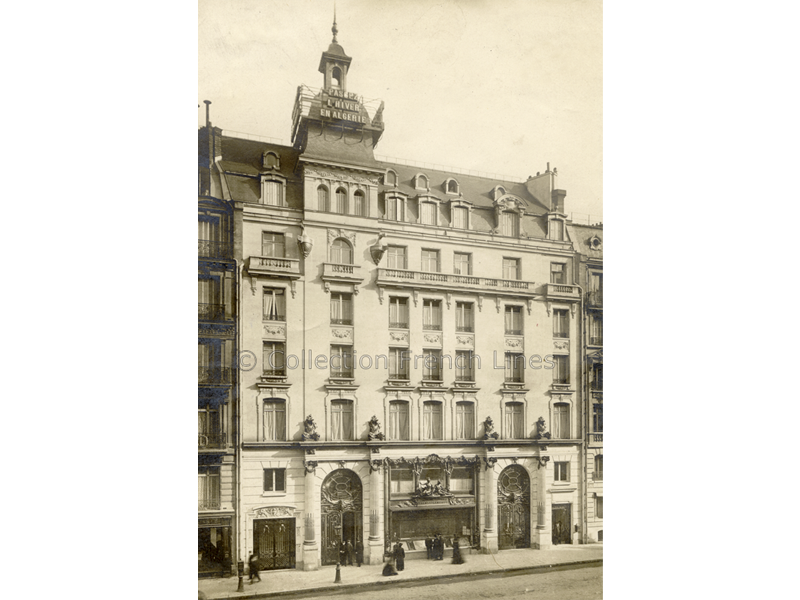
Anonymous. Compagnie Générale Transatlantique head office building in Paris

Anonymous. Compagnie Générale Transatlantique head office in Paris

Anonymous. Compagnie Générale Transatlantique agency in Le Havre

René Simon. Compagnie des Messageries Maritimes agency in Marseille

René Simon. Compagnie des Messageries Maritimes agency in Marseille

Anonymous. Compagnie Générale Transatlantique agency in Havana
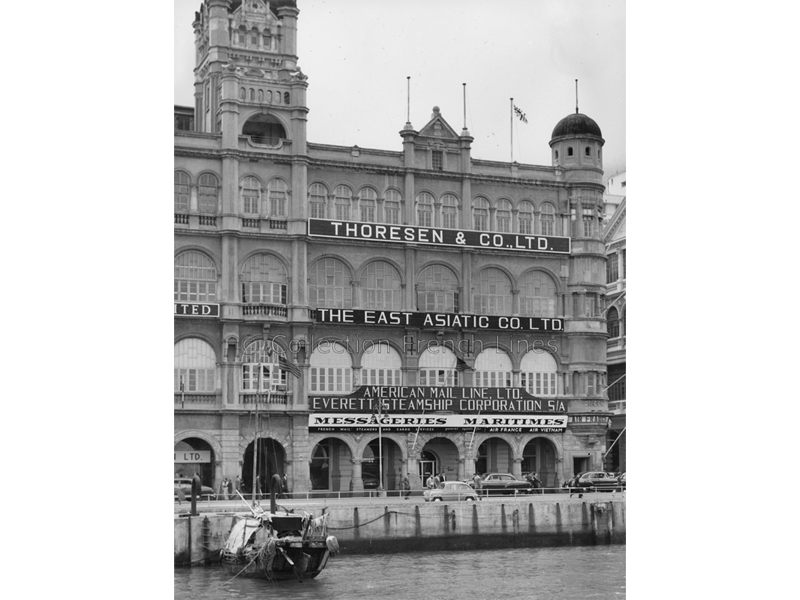
Anonymous. Compagnie des Messageries Maritimes agency in Hong Kong

Anonymous. Compagnie Générale Transatlantique agency in New York

Anonymous. Compagnie des Messageries Maritimes agency in Mahajanga

Anonymous. Compagnie Générale Transatlantique agency in Beverly Hills

Anonymous. Compagnie des Messageries Maritimes agency in Toamasina

Anonymous. Compagnie Générale Transatlantique agency in New York

Anonymous. Compagnie des Messageries Maritimes agency in Dunkirk
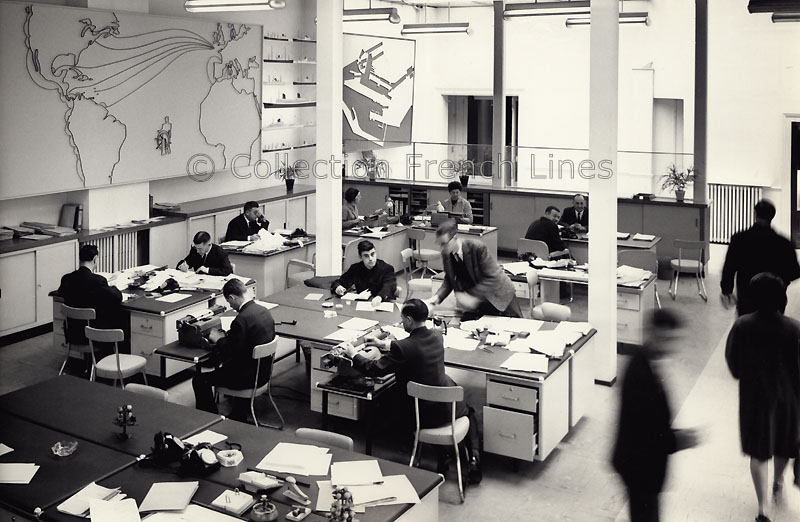
Anonymous. Compagnie Générale Transatlantique agency in Le Havre, 1964

Anonymous. Compagnie des Messageries Maritimes warehouses in Marseille

Anonymous. Car lift at the French Line ferry terminal in Le Havre, 1935

Anonymous. Compagnie Générale Transatlantique agency in Le Havre, 1931

Anonymous. Mechanical data processing center at the French Line agency in Le Havre (Ms. Bourgeant collection)
Onshore Staff
At the helm of the shipping companies, succeeding chairmen and emblematic personalities, facing the ebb and flow of history, rising to meet the challenges from foreign competition and managing staff with a wide variety of specialized professions. From the central administration departments at the head office in Paris to agencies in France and abroad, all of the different facets of maritime activity are managed to ensure that each journey runs as smoothly as possible.
Communication
Always aiming to grow their clientèle and strengthen customer loyalty, shipping companies cannot afford to neglect advertising. Apart from the famous posters and promotional prints, advertising for shipping lines and vessels also extends to urban areas (agency windows, newspaper stands, etc.) as well as various national and international events (exhibitions, fairs, shows, etc.). Taking promotional requirements to a whole new level, French Line even had its own printing house and advertising department staffed with creative professionals, such as the renowned Jean Auvigné, René Bouvard and Michel Lezla.
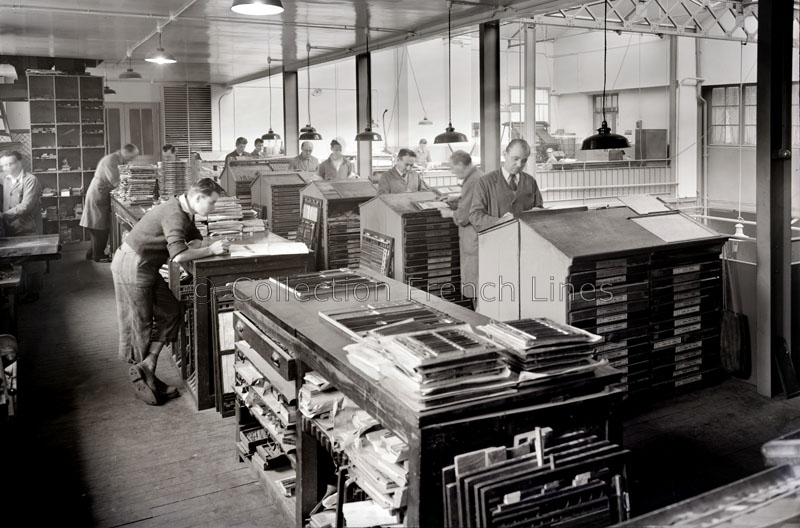
Anonymous. Typography workshop at the French Line printing house in Paris

Anonymous. French Line Stand at the 9th Salon Nautique in Paris, 1935

Anonymous. Ville d’Alger (CGT 1935) and North Africa crossings display

Anonymous. Window of the Compagnie Générale Transatlantique head office in Paris

Anonymous. Kiosk in Paris

Anonymous. French Line Stand at the Salon de la France d’Outre-Mer, 1935

Anonymous. The Blue Riband won by Normandie (CGT 1935) in the window of the head office

Anonymous. Window of the Compagnie Générale Transatlantique head office in Paris
Photojournalism
It was customary to call on the best photographers to commemorate ship launches, photograph every aspect of the liners and cargo ships, to promote the excellence of their staff and to entice people to embark on a sea voyage.

Byron Company. The liner France (CGT 1912) at the pier in New York

Byron Company. 1st class cabin on board the liner La Provence (CGT 1906)

Byron Company. Deputy Commandant Thoreux and Commandant Pugnet on board the Normandie (CGT 1935)
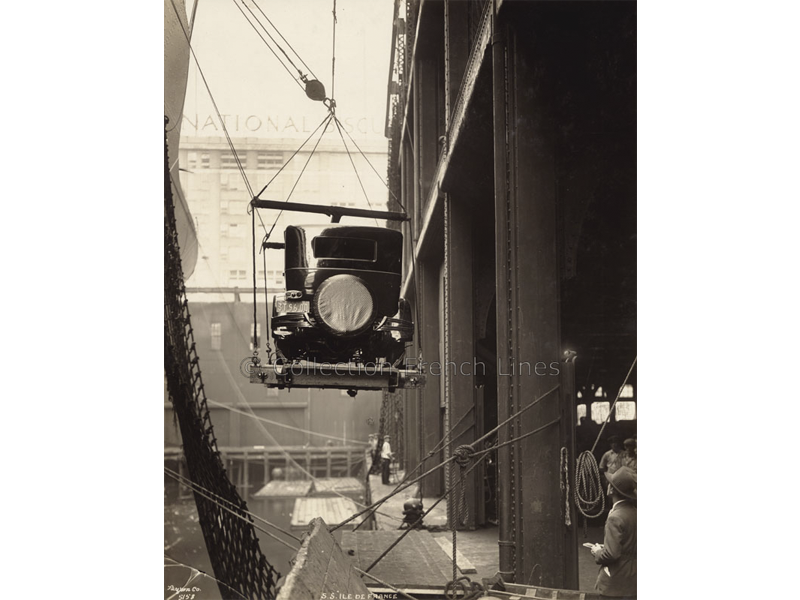
Byron Company. Handling a car at the pier in New York

Byron Company. The liner Ile-de-France (CGT 1927) and its seaplane at New York, close to the liner Roussillon (CGT 1920)

Byron Company. Students on board the training ship Jacques Cartier (CGT 1919)

Byron Company. 3rd class cabin on board the liner De La Salle (CGT 1921)

Byron Company. Model of the liner Normandie (CGT 1935) displayed in New York

Byron Company. Waiting room at the French Line agency (610 fifth av.) in New York

Byron Company. Engine control room of the liner Ile-de-France (CGT 1927)
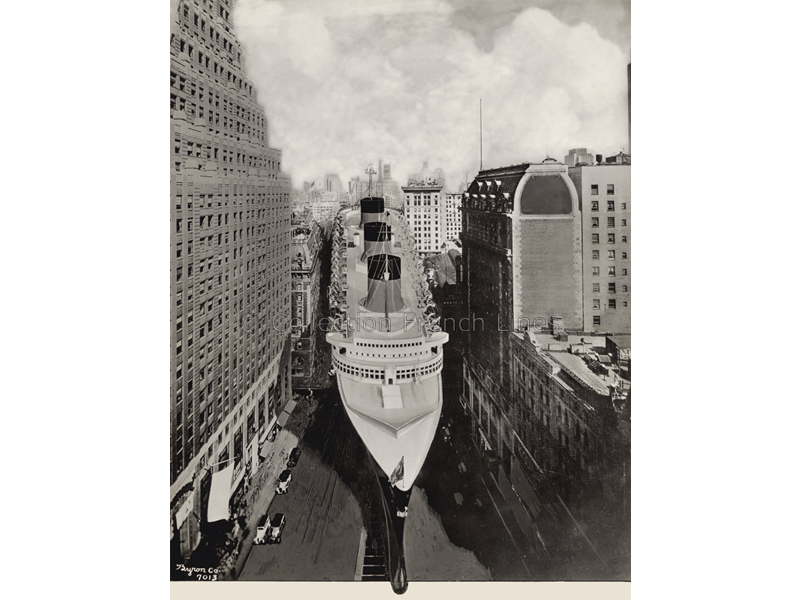
Byron Company. Photomontage of the liner Normandie (CGT 1935) in New York City

Byron Company. Staff and some of the crew from the liner Normandie (CGT 1935)
Byron Company
The Byron Company in New York, one of the most prestigious photographic agencies, was used by French Line from the beginning of the twentieth century until World War II. A photographer was sent on board each new vessel commissioned by French Line to capture a complete set of photographs—from the engine room to the navigation bridge via cabins and common areas—nothing escaped the expert eye of these professionals. These high-quality shots, featuring the vessel at the port as well as the service staff on board, served to attract an ever wider audience.

René Simon. Departure of the liner La Marseillaise (MM 1949) from Marseille
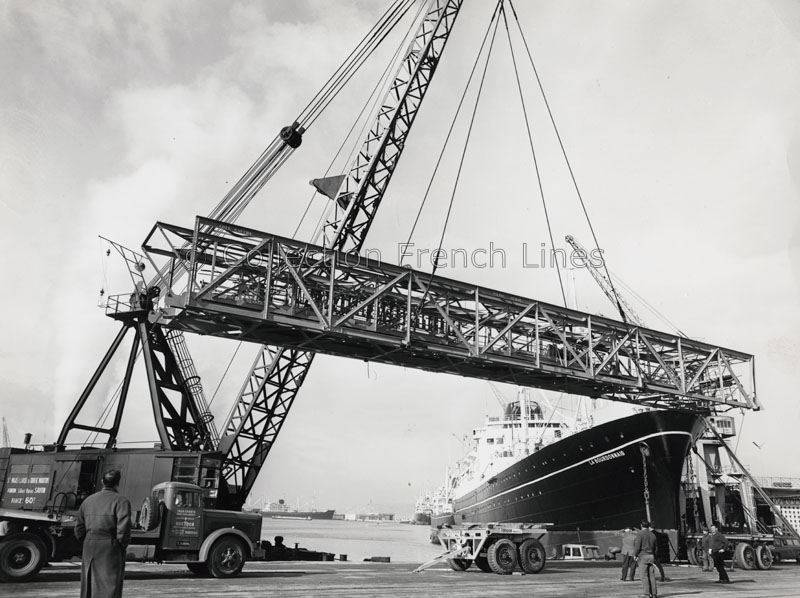
René Simon. Port handling at Marseille in front of the liner La Bourdonnais (MM 1953)

René Simon. Descent from the 1st class lounge on board the liner Pierre Loti (CGT 1953)

René Simon. Embarking on the 3rd French expedition to the Himalayas on board the Athos II (MM 1927), 1951

René Simon. Engine room of the cargo ship Iraouaddy (CGT 1953)

René Simon. Unloading banana bunches from the liner Jean Laborde (MM 1953) in Marseille, 1961

René Simon. Awarding of the Croix de Guerre to the liner Félix Roussel (MM 1931), 1950

René Simon. 1st class bar on board the liner Jean Laborde (MM 1953)

René Simon. The liner La Marseillaise (MM 1949), converted into a hospital ship

René Simon. Aerial view of the Old Port in Marseille, 1956

René Simon. Coupled liners Calédonien (MM 1952) and Ferdinand de Lesseps (MM 1952)

René Simon. Launch of the tanker Centaure (MM 1960) at the Chantiers de La Ciotat, July 23, 1959
René Simon
A photographer from Marseille who was vital to industrial, maritime and air transportation companies, René Simon (1906-1994) completed a substantial body of work for the Compagnie des Messageries Maritimes. This shipping community aficionado was the preferred photographer for many years for major events at the Marseille company and for portraits of its vessels. Scenes of port life, ship launches, photographs of accommodation, etc. René Simon’s work was both broad and prolific.
Community-based Companies
Buildings linked to maritime operations in port towns with a large shipping presence are diverse and numerous. In Dunkirk, Le Havre, Marseille and Bordeaux, passengers are largely familiar with the ferry terminals where the train takes them to the ships, the agencies where they can buy their ticket and the countless hangars where goods in transit are stored. Onshore staff in the technical, armament and supplies departments are bustling about in offices, warehouses and various workshops to ensure that vessels are operating before departure and arrival. The buildings were also used at other times to house sailors during stopovers, social welfare services for families of seagoing personnel or for the transit of migrants.
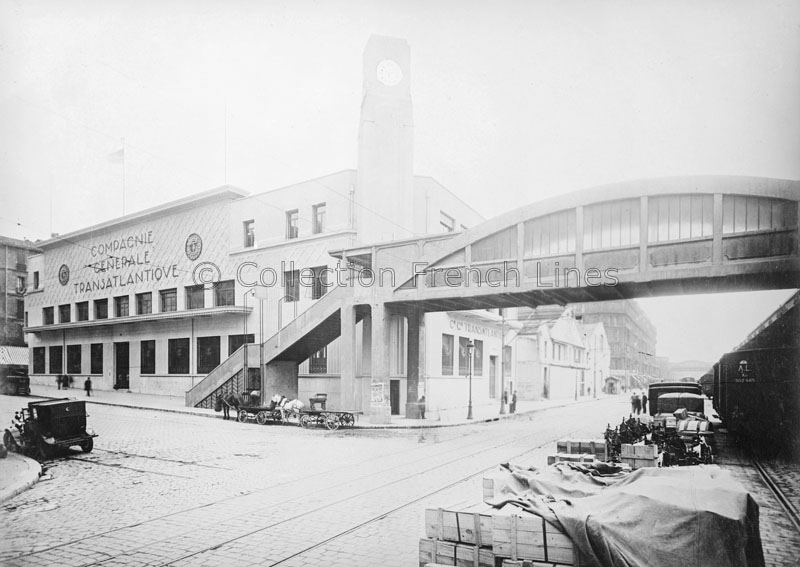
Anonymous. Compagnie Générale Transatlantique agency in Marseille

Anonymous. Compagnie des Messageries Maritimes warehouses in Marseille

Anonymous. Facilities at the French Line agency in Le Havre, 1949

Anonymous. Fitting out building loading dock at the French Line agency in Le Havre, 1949

Anonymous. Nursery at the Transatlantique residence in Le Havre (Ms. Sabarly collection)

Anonymous. Compagnie des Messageries Maritimes warehouses in Marseille

Anonymous. Compagnie des Messageries Maritimes hangar in Algiers

Anonymous. Transatlantique residence in Le Havre, 1955

Anonymous. Dining room at the migrant hotel, Rue de Phalsbourg, Le Havre

Anonymous. Dining room at the migrant hotel, Le Havre

Anonymous. Medical check for migrants in Le Havre, 1909

Anonymous. Disinfection chambers at the migrant hotel, Le Havre

Anonymous. French Line and the Compagnie des Chargeurs Réunis emigration agency at Ljubljana
